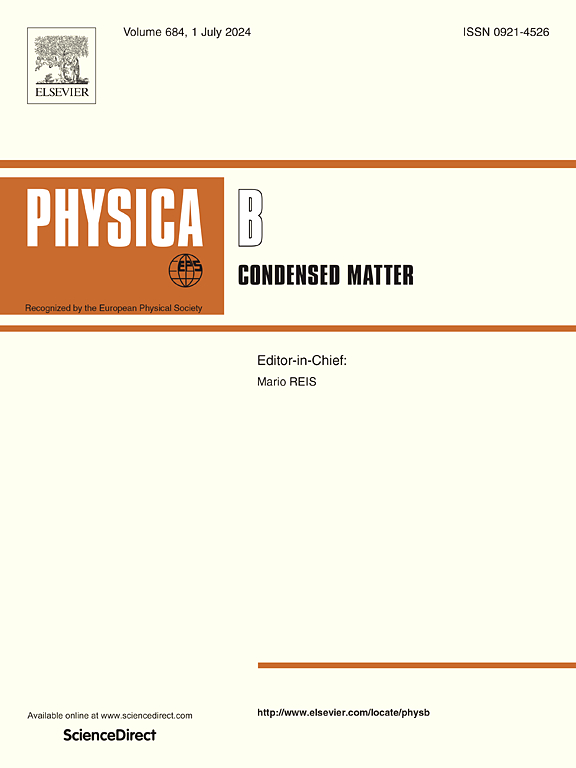Gd2O3修饰和Pr3+掺杂硼酸盐玻璃通过Gd到Pr的能量转移对蓝色和紫外光激发wled的发光和辐射特性
IF 2.8
3区 物理与天体物理
Q2 PHYSICS, CONDENSED MATTER
引用次数: 0
摘要
研究了混合Gd2O3在20Li2O3-30SrO-(49-x)B2O3-xGd2O3-1Pr2O3玻璃中的XRD、FTIR、结构变化因素、光学吸收、发光和辐射行为。利用Judde-Ofelt (J-O)分析了吸收光谱,推导了强度参数。利用折射率和Ωλ = 2,4,6值来计算Pr3+发光态的分支比(βR)和辐射跃迁概率(AR)。在波长为444 nm的光泵浦中,估计了3Po→3H4跃迁中显著光增益和增益带宽等关键因素对设计可见激光系统的影响。Gd3+离子通过ET使Pr3+离子从6P7/2状态敏化到Pr3+离子的3PJ = 2,1 0状态。从发光光谱中提取的国际委员会Éclairage (CIE)、相关色温(CCT)和色纯度(CP)值显示出白光的发射。这些结果对wled和光学放大具有启示意义。本文章由计算机程序翻译,如有差异,请以英文原文为准。
Luminescence and radiative features of Gd2O3 modified and Pr3+ doped borate glass via energy transfer from Gd to Pr for blue- and UV-excited WLEDs
We investigate the XRD, FTIR, structure variation factors, optical absorption, luminescence and radiative behaviors of mixed Gd2O3 in a 20Li2O3-30SrO-(49-x)B2O3-xGd2O3-1Pr2O3 glass. The Judde-Ofelt (J-O) analysis of the absorption spectra is performed to deduce intensity parameters. The refractive index and Ωλ = 2, 4, 6 values are employed to evaluate the branching ratios (βR), and radiative transition probabilities (AR) of Pr3+ luminescent states. At a wavelength of 444 nm for optical pumping, critical factors such as significant optical gain, and gain bandwidth in the 3Po → 3H4 transition for designing visible laser systems are estimated. The Gd3+ ions sensitize the Pr3+ ions through ET from their 6P7/2 state to the 3PJ = 2, 1, 0 states of Pr3+ ions. The extracted Commission Internationale de l'Éclairage (CIE), correlated color temperature (CCT) and color purity (CP) values from the luminescence spectra demonstrate the emission of white light. These results have implications for WLEDs and optical amplification.
求助全文
通过发布文献求助,成功后即可免费获取论文全文。
去求助
来源期刊

Physica B-condensed Matter
物理-物理:凝聚态物理
CiteScore
4.90
自引率
7.10%
发文量
703
审稿时长
44 days
期刊介绍:
Physica B: Condensed Matter comprises all condensed matter and material physics that involve theoretical, computational and experimental work.
Papers should contain further developments and a proper discussion on the physics of experimental or theoretical results in one of the following areas:
-Magnetism
-Materials physics
-Nanostructures and nanomaterials
-Optics and optical materials
-Quantum materials
-Semiconductors
-Strongly correlated systems
-Superconductivity
-Surfaces and interfaces
 求助内容:
求助内容: 应助结果提醒方式:
应助结果提醒方式:


